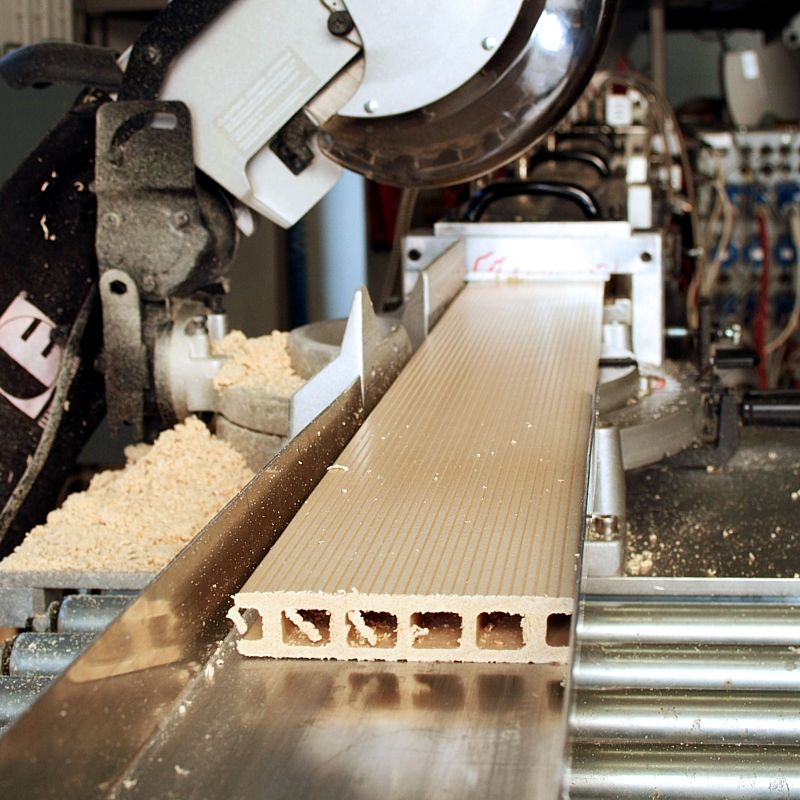The main areas of production include patio decking, façade elements and fencing, furniture and vehicle interior parts. Their development originated in the USA, where wood was used as an affordable and sustainable filling material in thermoplastically-processible plastics. In the USA, recycled plastics such as PE and PVC are used to a great extent. In Europe, PP is implemented foremost as the matrix. A significant advantage of WPC over solid wood is the high three-dimensional diversity of shape and size, gained through the process technique, and the resulting non-necessity of machining (compared to the manufacture of products from fibre-board material). This results in reduced waste during processing and lower energy consumption. The water absorption of WPC is low and treatments such as painting and impregnating are generally not necessary. Also, the plastic content of WPC makes the product more resistant to weather influences as well as mould and insect infestations. Furthermore, material recycling enables cascade usage of the sustainable raw materials and the implemented polymers.
For the polymer matrix, polyethylene (PE), polypropylene (PP), polystyrene (PS) and polyvinyl chloride (PVC) are primarily used, due to the relatively low price and the low melting point, as the thermal demand of wood at temperatures of over 200°C is too high. These polymers are, however, not suitable for most structural applications due to their creep behaviour and their low dimensional stability under heat. Load-bearing elements from WPC must display significantly better mechanical characteristics than PP or PE-based WPC.
The application of high-performance plastics as matrix is severely constricted by the provisions of the melting temperature. Additionally, the high price of potentially more technical polymers is economically non-viable. In order to nonetheless be able to offer WPC with significantly improved mechanical properties at an acceptable price, it is necessary to develop and implement polymer blends as a realistic solution.
The planned project will begin by identifying PP and/or PE-based polymer blends, as PP and PE are, from a technical standpoint, fundamentally suitable as the matrix for WPC and are also recommendable due to their low cost. Additionally, PP and PE will be used as homogeneous recycled material and tests will be carried out to determine whether the characteristics hereby achieved can attain the level of WPC produced on the basis of new plastic materials. Potential technical polymers for the development of blends are various polyamides, polymethylmethacrylate (PMMA), acrylonitrile-butadiene-styrene (ABS) or also polycarbonate (PC), a small amount of which should also effect an improvement in the mechanical properties. Initially, blends suitable for this purpose will be developed, which will then, in co-operation with WPC manufacturers and machine manufacturers, be processed with sawdust or other lignocellulose filling materials and reinforcing fibres. The resulting mechanical characteristics will then be compared to the requirements of the quality and testing regulations for WPC decking boards (Association of German Wood-Based Materials Industry, VHI e.V.).
Simultaneously, an ecological assessment of the newly-developed polymer blend-based WPC will be carried out. This evaluation will compare the new products with conventional alternatives and commercially-available wood polymer composites. The results of the ecological evaluation will be incorporated into the optimisation and further development of application-relevant characteristics of polymer blend-based WPC in the form of new and recycled plastics. These include the weather resistance, dimensional stability under heat and possibly also fire protection. In co-operation with additive manufacturers, an optimal composition of the WPC formulation will be developed. The weather resistance will be tested through short-term and long-term exposure. If applicable, the flammability of the WPC samples will be determined through selected fire tests.
 Fraunhofer Institute for Wood Research
Fraunhofer Institute for Wood Research 

